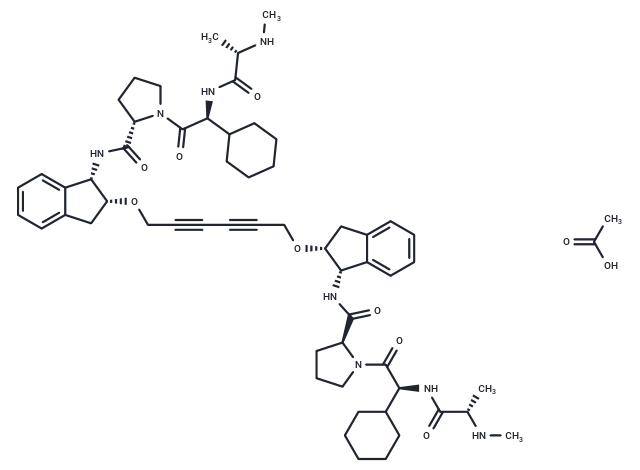Shopping Cart
Remove All Your shopping cart is currently empty
Your shopping cart is currently empty
AZD5582 acetate is an inhibitor of IAPs, which binds to the BIR3 domains cIAP1, cIAP2, and XIAP with IC50s of 15, 21, and 15 nM, respectively. AZD5582 induces apoptosis.

| Pack Size | Price | USA Warehouse | Global Warehouse | Quantity |
|---|---|---|---|---|
| 2 mg | $89 | Inquiry | Inquiry | |
| 5 mg | $128 | Inquiry | Inquiry | |
| 10 mg | $189 | Inquiry | Inquiry | |
| 1 mL x 10 mM (in DMSO) | $275 | - | In Stock |
| Description | AZD5582 acetate is an inhibitor of IAPs, which binds to the BIR3 domains cIAP1, cIAP2, and XIAP with IC50s of 15, 21, and 15 nM, respectively. AZD5582 induces apoptosis. |
| Targets&IC50 | XIAP:15 nM, CIAP2:21 nM, CIAP1:15 nM |
| In vitro | AZD5582 (20 nM; 48 hours) inhibited cell viability by cooperation with IFNγ or viral double-stranded RNA (dsRNA) in H1975 NSCLC cells[2]. AZD5582 (20 nM; 48 hours) involves in apoptosis due to induction of cell death and active caspase-3/ -8 activities by AZD5582 and IFNγ co-treatment in HCC827 NSCLC cells[2]. AZD5582 (20 nM; 17 or 25 hours) down-regulates cIAP-1, activates RIPK1( upstream regulator of caspase-8), and triggers the activation of extrinsic (caspase-8) and intrinsic (caspase-9) apoptosis pathways, causing the cleavage of caspase-3 and caspase-7[2]. |
| In vivo | AZD5582 (intravenous injection; 0.1-3.0 mg/kg; once a week; 2 weeks) causes degradation of cIAP1 and caspase 3 cleavage in tumor cells, and after a two-week treatment, the tumors largely resolved. When the mice are given a medium dose (0.5 mg/kg) of AZD5582, cIAP1 degrades after administration, but it takes a while time to reach apoptosis-inducing effect[1]. |
| Molecular Weight | 1075.36 |
| Formula | C60H82N8O10 |
| Smiles | C[C@H](NC)C(N[C@H](C(N1CCC[C@H]1C(N[C@@H]2[C@H](OCC#CC#CCO[C@@H]3CC4=CC=CC=C4[C@@H]3NC([C@@H]5CCCN5C([C@@H](NC([C@@H](NC)C)=O)C6CCCCC6)=O)=O)CC7=CC=CC=C27)=O)=O)C8CCCCC8)=O.CC(O)=O |
| Relative Density. | no data available |
| Color | White |
| Appearance | Solid |
| Storage | Powder: -20°C for 3 years | In solvent: -80°C for 1 year | Shipping with blue ice/Shipping at ambient temperature. | ||||||||||||||||||||||||||||||
| Solubility Information | DMSO: 55 mg/mL (51.15 mM), Sonication is recommended. | ||||||||||||||||||||||||||||||
Solution Preparation Table | |||||||||||||||||||||||||||||||
DMSO
| |||||||||||||||||||||||||||||||
| Size | Quantity | Unit Price | Amount | Operation |
|---|

Copyright © 2015-2026 TargetMol Chemicals Inc. All Rights Reserved.